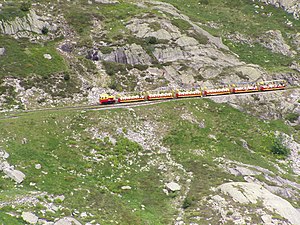Petit train d'Artouste
| Petit train d'Artouste | |||||||||||||||||||||||||||||||||||||||||
|---|---|---|---|---|---|---|---|---|---|---|---|---|---|---|---|---|---|---|---|---|---|---|---|---|---|---|---|---|---|---|---|---|---|---|---|---|---|---|---|---|---|
| Route length: | 9.5 km | ||||||||||||||||||||||||||||||||||||||||
| Gauge : | 500 mm ( narrow gauge ) | ||||||||||||||||||||||||||||||||||||||||
| Petit train d'Artouste | |||||||||||||||||||||||||||||||||||||||||
|
|||||||||||||||||||||||||||||||||||||||||
The Petit train d'Artouste is a tourist narrow-gauge railway that is almost 10 km long in the French Pyrenees .
Geographical location
The track is located in the municipality of Laruns in the southwestern French region Nouvelle-Aquitaine in the department of Pyrenees-Atlantiques . It runs at an altitude of around 2000 m in the Ossau Valley between the Pic-de-la-Sagette and the Lac d'Artouste , a reservoir .
history
The Compagnie des chemins de fer du Midi began an extensive electrification program using the hydropower of the northern Pyrenees as early as 1909. To this end, it built its own network of reservoirs , water pipes, power stations and high-voltage lines . The dammed Lac d'Artouste , located at the foot of glaciers, should also be integrated into this system . The construction site to be set up for the dam was difficult to reach and was served by a system consisting of a material ropeway and an adjoining construction site railway.
The 500-mm-gauge construction site railway was built between the mountain-side end of the material cable car, the Pic-de-la-Sagette, and the later location of the dam in front of the Lac d'Artouste, along the underground water line from 1921 to 1924 running water pipeline built. From there there were connecting tunnels to the parallel railway line, via which work material was delivered and excavation was carried out. After the construction work was completed in 1924, it took five years to fill the reservoir , and in 1929 the facility went into operation. At the same time, the material ropeway was given a cabin with five places for passenger transport.
In 1932, at the suggestion of the department and also in the self-interest of the Compagnie des chemins de fer du Midi , in order to stimulate tourism, passenger traffic was started: initially only in the two summer months and on Sunday, each with two pairs of trains, the consisted of a locomotive and two or three cars. The wagons were flat wagons on which wooden benches were placed. At that time, the railway owned three diesel locomotives from Renault with the road numbers R1–3 and two from Automobiles Unic (U1 and U2). In 1948 the locomotive fleet was supplemented by two more diesel locomotives, this time by Jules Weitz .
Six years later (1938) the railway was nationalized together with the "Midi" in the SNCF . In 1957, the capacity of the cable car to the Pic-de-la-Sagette was increased: It was switched to the operation with two cabins, each with 32 passengers. This enabled it to transport 300 passengers per hour. In 1963 the locomotive park was replaced: The train received six locomotives from Billard (D3-D8) and five according to plans by Whitcomb, Chicago , which were assembled in France (D9-D13). Also in 1963 the rails were completely replaced. In 1968 the railway received 31 new passenger cars to increase travel comfort. This year more than 30,000 passengers traveled by train.
In 1980, the SNCF handed over the railway operations to the department. The SNCF later outsourced the power stations to its own company, Société hydroélectrique du Midi (SHEM), which remained the owner of the railway infrastructure and the railway vehicles . The department operates the railway together with the surrounding mountain railways under the company EPSA (Etablissement Public des Stations d'Altitude). As part of an investment program from 1981 to 1983, the department built a new gondola lift as a feeder for the railway with a capacity of 1,200 passengers per hour. Additional wagons and locomotives were procured for the railway itself. In 2006 all vehicles were overhauled and the locomotives were equipped with new engines. Today the railway carries 130,000 passengers per season.
Technical parameters
The track has a track width of 500 mm. It operates as an island operation with diesel locomotives . The cruising speed is about 10 km / h.
The north-western end point of the route, the Pic-de-la-Sagette, is reached by two cable cars : the new gondola lift from the 1980s for tourists and the old system from the 1950s, which is now used exclusively for operational purposes by the SHEM becomes.
literature
- Henri Domengie: Les petits trains de jadis - Volume 7: Sud-Ouest de la France. Editions du Cabri, Breil-sur-Roya 1986, ISBN 2-903310-48-3
- Sophie Ponsolle: Il était une fois… le petit train d'artouste . 2nd edition 2003. ISBN 2-9514106-3-8 (reprint from 2016).
Web links
Individual evidence
- ↑ Ponsolle, p. 10.
- ↑ Ponsolle, p. 10.
- ↑ Ponsolle, p. 11.
- ↑ Ponsolle, p. 27.
- ↑ Ponsolle, p. 27.
- ↑ Ponsolle, p. 33.
- ↑ Ponsolle, p. 32.
- ↑ Ponsolle, p. 33.
- ↑ Ponsolle, p. 35.
- ↑ Ponsolle, p. 33.
- ↑ Ponsolle, p. 36.
- ↑ Ponsolle, p. 35.
- ↑ Ponsolle, p. 38.
Coordinates: 42 ° 53 '52 " N , 0 ° 23' 46.2" W.


